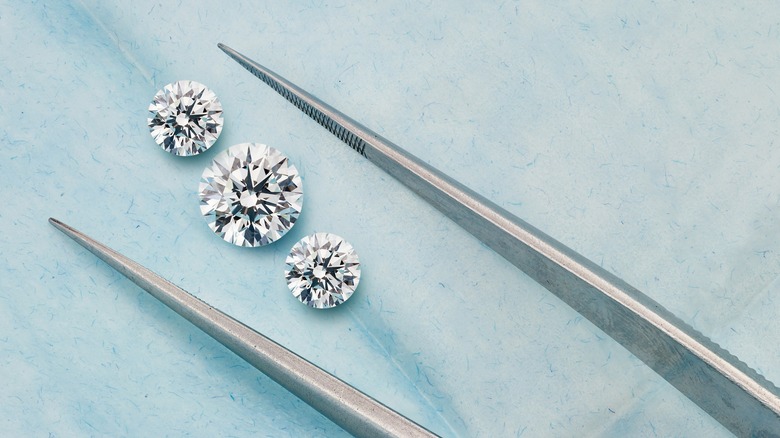How To Tell The Difference Between Lab-Grown Diamonds And Natural Diamonds
Despite being around since the 1950s, lab-grown diamonds have only recently exploded in popularity. Allied Market Research states that, in 2022, the global diamond market was valued at $100.4 billion but is projected to hit $155.5 billion by 2032. While demand for genuine diamonds remains higher than for the synthetic alternative, lab-grown diamond sales increased by 16% from 2022 to 2023, which means they will likely form a large part of that growth by 2032.
There are multiple factors driving this trend, including a perceived sustainability advantage — though this has been called into question in recent years. Otherwise, there are lots of verifiable advantages to lab-grown diamonds. Not only are they a lot cheaper than the naturally-occurring stones, telling the difference between the two is basically impossible to do with the naked eye. That's because the differences between synthetic and natural diamonds are extremely subtle and can only be seen using specialized equipment and processes. Otherwise, the elements that make up natural diamonds are essentially the same as those that make up their lab-grown counterparts, meaning both types of these rare crystals have the same physical and chemical structure.
So, how exactly can you tell the difference between lab-grown and natural diamonds, and is it really that difficult to do?
How are natural diamonds formed?
Natural diamonds are formed deep underground — typically 100 miles or so below the Earth's surface in a layer called the upper mantle — and brought to the surface by volcanic eruptions. Certain conditions are required for diamonds to form, namely intense pressure and heat. Temperatures can range from 900 to 1,300 degrees Celsius (1,652 to 2,372 degrees Farenheit) while pressure reaches the equivalent to 50,000 times the atmospheric pressure at the Earth's surface.
This process forces carbon molecules to crystallize over the course of millions — or sometimes billions — of years, a process which involves a carbon atom bonding to four other carbon atoms, creating an extremely strong connection that gives diamonds their reputation for being so strong. Billions of carbon atoms locked together create crystalline structures. The crystals' strength is part of the reason diamonds are used in drills, saw blades, and other tools that require a robust sturdiness.
How are lab-grown diamonds made?
Lab-grown diamonds have been around since the mid-1950s when GE created the first synthetic versions of the gems. Today, there are two main methods of producing lab–grown diamonds: the HTHP (high pressure/high temperature) process and the CVD (chemical vapor deposition) process. The first method attempts to emulate the conditions under which natural diamonds are formed, using, as the name suggests, high pressure and high temperature to create the crystals in a lab. In contrast, the CVD Process involves applying temperature and pressure to a gaseous hydrocarbon mixture, forcing it to essentially solidify on a small diamond seed.
But while both types of lab-grown diamonds have the same chemical make-up as natural alternatives, they do have certain markers that allow scientists to tell them apart from their Earth-forged counterparts. GIA Distinguished Research Fellow, Dr. James Shigley spoke to Diamond Mansion and highlighted the difference in growth morphology between natural and synthetic diamonds. That essentially means that diamonds forged in the earth will have subtle differences in their structure when compared to those grown in a lab — none of which are observable with the naked eye.
What are the differences between natural and lab-grown diamonds?
For gemologists, there are quite a few details to be had when it comes to the markers that help identify lab-grown diamonds — and even the differences between HPHT and CVD diamonds — on their website. Examples include uneven color distribution and a lack of strain patterns on HPHT diamonds, as opposed to even color distribution and banded strain patterns on CVD versions. Not every lab-grown diamond will feature all these markers, and it is therefore a case of trying to identify as many of them as possible to ascertain whether a diamond is lab-grown or natural, and, in the case of the former, to pinpoint the specific type of synthetic diamond.
If that sounds complex, it very much is. Finding the difference between a natural and a synthetic diamond is an in-depth process whereby gemologists using specialized equipment rely on subtle nuances to differentiate the two. For example, natural diamonds contain trace amounts of nitrogen, while lab-grown alternatives do not. There's also the example of color zoning, which appears on both natural and HPHT diamonds, but in the latter's case, it will also show geometric patterns within that zoning.
This are just some examples of dozens of markers that can separate the different types of diamonds. Other tests include using fluorescence imaging to view the growth patterns of diamonds, with natural stones showing concentric patterns, HPHT stones showing cross-shaped patterns, and CVD stones showing striations. When taken together, these markers help gemologists determine what kind of stone they're dealing with.



